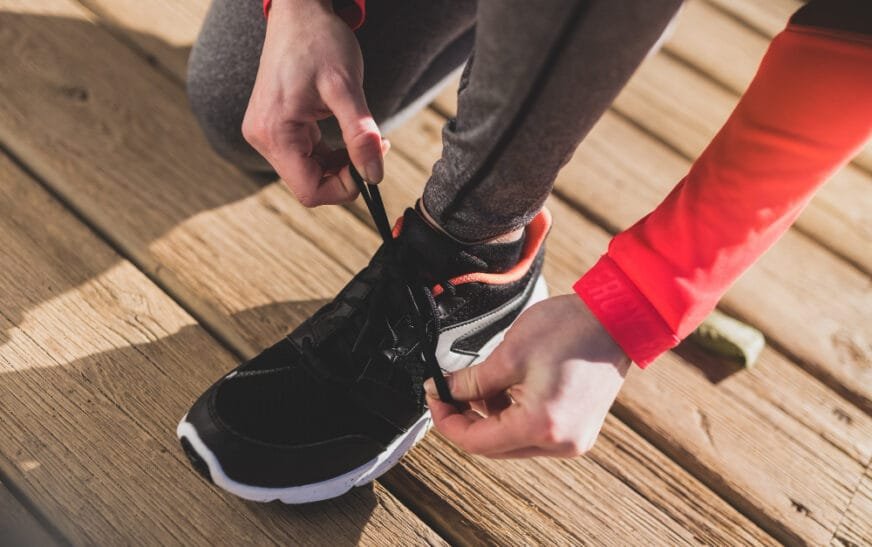Choosing the right running shoes can make a huge difference in comfort, performance, and injury prevention. There are two popular types of shoes, neutral running shoes, and stability running shoes, and they are designed for different foot types and running styles. Neutral shoes are better for runners with a natural stride, and stability shoes provide extra support for those who need extra comfort. Understanding these differences between the two shoes can make it easier for you to make a decision and find the perfect pair for your running needs.
The importance of choosing the right running shoes for injury prevention and performance.
Choosing the correct type of running shoes is important for injury prevention and good performance. Proper footwear supports your feet, aligns your posture, absorbs shock, and further reduces the risk of common running injuries. Choosing the shoes that are the best for your foot type and gait will give you the right cushioning and stability, making sure you feel comfortable during long runs and further improving your efficiency.
Other than prevention of injury, the right shoes will also improve your performance by giving you energy return, grip and speed. Buying the shoes that are perfect for your body type and running style can make your runs safer and more enjoyable.
What are Neutral Running Shoes?
Neutral running shoes are made for runners who have a natural foot movement, which means that their feet don’t roll inward or outward excessively while running. The main point of neutral running shoes are the cushioning and comfort rather than the support or stability. These kinds of shoes are perfect for people who have neutral gait or high arches.
Advantages:
- Comfortable Cushioning: They provide a softer, more natural running experience for everyone.
- Lightweight Design: These types of shoes are generally lighter, allowing for better speed and performance.
- Versatility: These are suitable for various types of running styles.
Disadvantages:
- Limited Support: Neutral running shoes are not ideal for those who overpronate or need extra stability.
- Durability Concerns: Because there is no extra added support, these shoes might wear out quicker than others.
What are Stability running shoes?
Stability running shoes are made to support runners who overpronate, meaning their feet roll inward too much when running. These shoes have extra support and cushioning, especially in the arch area, and it helps correct the stride and provide better alignment while running.
Advantages:
- Reduces Risk: Stability Shoes help reduce the risk of injuries caused by overpronation.
- Better Support: They provide better arch support and cushioning for comfort.
- Posture: These shoes improve overall running posture and efficiency.
Disadvantages:
- Heavy: May feel heavier than neutral shoes.
- Stability shoes are not ideal for runners with a natural stride.
- They can limit a runner’s flexibility for some runners.
Difference between Neutral and Stability Running Shoes
| Neutral Shoes | Stability Shoes | |
| Support | These provide normal cushioning without extra support and are designed for runners with a natural gait who don’t overpronate. | These offer added support, especially in the foot arch area, to control overpronation and ensure proper alignment. |
| Foot Type | Best for runners with neutral arches or for those who supinate | Best for runners with low arches or flat feet who tend to overpronate. |
| Cushioning | Focuses mainly on comfort and shock absorption for natural movement. | Combines cushioning with structured support to correct foot motion. |
| Weight | Tends to be lighter and more flexible for a natural feel. | Slightly heavier due to the added support features. |
| Running Style | Better suited for efficient runners with proper form. | Beneficial for runners needing extra guidance to avoid strain and injuries. |
How to determine your foot type and running style?
1. The Wet Foot Test:
Wet your foot and step on a piece of paper or a flat surface. Note what kind of imprint your foot is giving:
– If your whole foot leaves an imprint, then you have a flat foot.
– If a part of your foot arch is missing, then you have a normal arch.
– If only the heel and the ball of your foot are visible, then you have a high arch.
2. Analysis at Store:
Many shoe stores in the city are offering an analysis by the use of treadmills and cameras. You can get yours professionally done at one of these stores.
How to Choose the Right Shoe Type for You
1. Know Your Foot Type:
Do one of the tests to know what your foot type is. If you have flat feet, it is better to use stability running shoes. If you have normal/high arch feet, then it is better to use neutral running shoes.
2. Consider Your Activity:
For running long distances, it is better to choose shoes that have cushioning and provide support. For casual everyday wear, you can choose lightweight, flexible shoes.
3. Try Before Buying:
Before buying the shoes, walk around wearing them for a while to understand the comfortability of the shoes. Make sure they don’t feel too tight or too loose.
4. Think About the Area:
If you are looking for shoes to use on the road, then any standard running shoes can be used. For hikes and trails, it is better to choose shoes that have a better grip.
Common Myths About Running Shoes
There are a number of myths regarding running shoes. Here are some myths and the truths of running shoes.
1. Myth: Expensive shoes are better than normal ones.
Truth: The price range of the shoe is not directly proportional to how good or bad the shoe is. The perfect shoe depends on the person’s foot type, running style and comfort.
2. Myth: You need shoes with the most cushioning for comfort.
Truth: Cushioning is important but too much cushioning can become a problem as it leads to instability.
3. Myth: New running shoes should feel perfect immediately.
Truth: New shoes might feel stiff in the beginning but they start to feel comfortable as they are worn.
4. Myth: All running shoes are the same, it doesn’t matter which you choose.
Truth: Running shoes are designed for different foot types and people’s personal needs.
Top Neutral and Stability Running Shoes for 2025
For 2025, here are some of the top neutral running shoes –
- Brooks Ghost 15 – It is one of the best due to its smooth, balanced fit.
- On Cloudsurfer 16 – It does not have too much cushioning and is good for a firm run.
- Asics Gel Cumulus 24 – This is perfect for long distance running.
- Hoka Clifton 9 – This shoe provides a perfect balance of softness and propulsion.
The top stability running shoes in 2025 are –
- Asics Gel Kayano 30 – This shoe provides amazing arch support and stability.
- Saucony Guide 16 – This shoe has moderate cushioning and gives good support.
- Altra Provision 6 – This shoe is good for people who are looking for stability and natural running feel.
- Nike React Infinity Run Flyknit 3 – The cushioning and design is ideal for stability running.
FAQs
Can neutral runners wear stability shoes?
Yes, neutral runners can wear stability shoes but it depends on the individual’s running goals and comfort level. If the runners are experiencing discomfort in their ankles or knees or they want extra cushioning, then they can opt for stability shoes.
How often should running shoes be replaced?
Running shoes are usually replaced every 500 to 800 kilometers but it also depends on other factors like running style, shoe material, how often they run, and the surfaces the person runs on.
Do stability shoes help with knee pain?
Stability shoes can help with knee pain, especially if you have flat feet. They provide extra support and cushioning, which can improve alignment and reduce stress on your knees. However, if knee pain is due to injuries or other issues, stability shoes might not solve the problem, and you may need expert advice.
Is it better to have custom insoles or buy stability shoes?
Custom insoles are better if you have foot problems like severe overpronation or chronic pain, because custom insoles are made for your needs. Stability shoes are great for general support and mild to moderate overpronation. If you’re unsure, consult a specialist to find what works best for your feet.
Conclusion
Choosing between neutral and stability running shoes depends on your foot type and running style. Neutral running shoes are perfect for runners with a natural stride, while stability shoes offer extra support for those who overpronate. It’s important to know your foot type and comfort to find the right fit for injury prevention and performance, making sure your shoes align with your personal needs.











